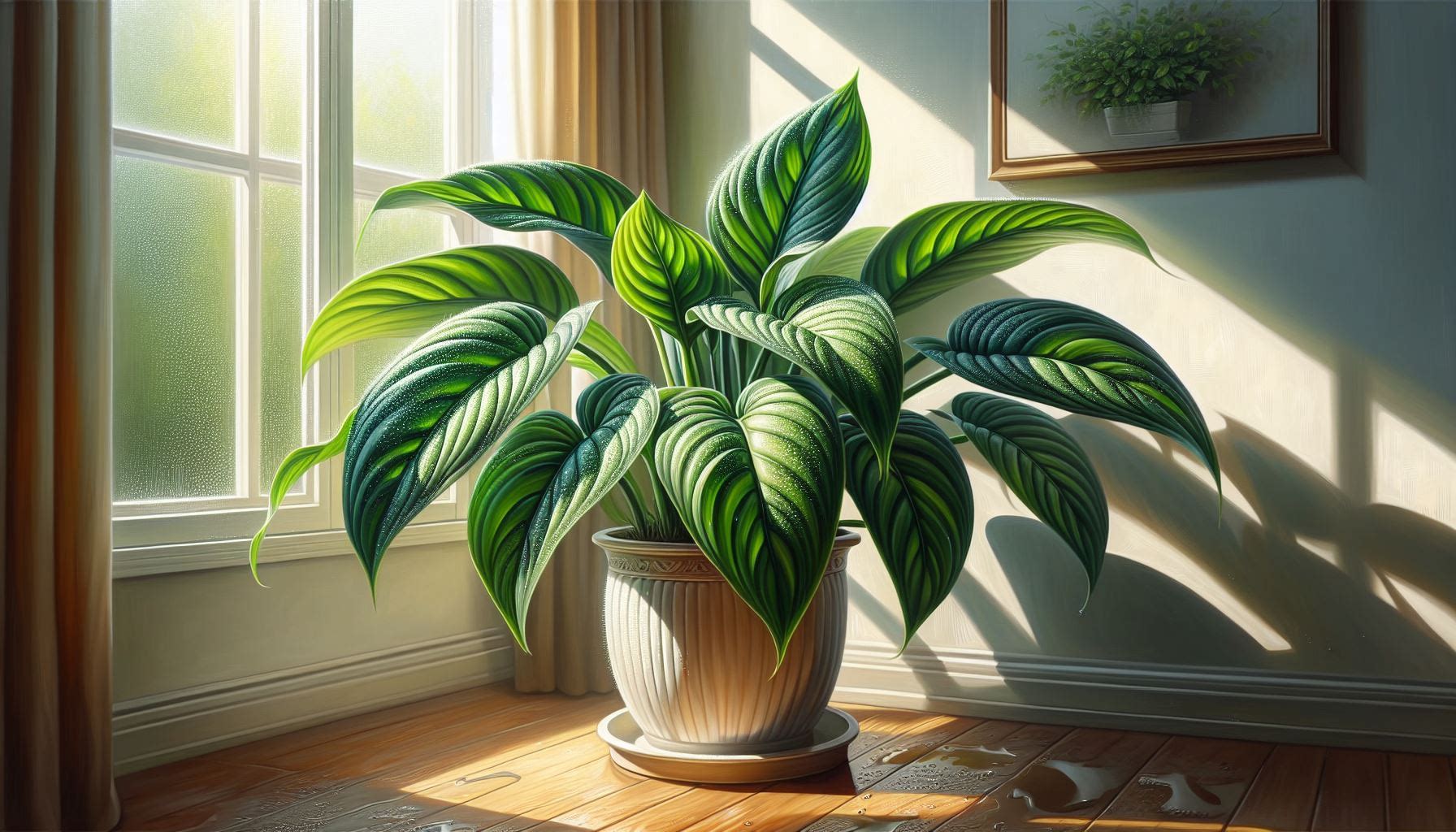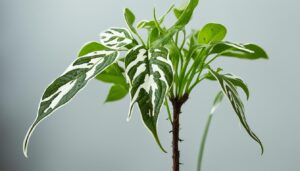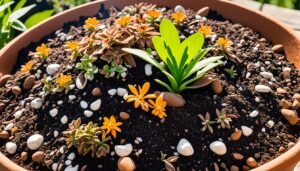Introduction
In the rich tapestry of
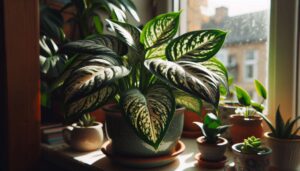
botanical wonder, Dieffenbachia emerges as a captivating protagonist, boasting a plethora of distinct varieties, each with its own unique allure. These lush, leafy plants, commonly known as dumb canes, have long captured the attention of plant enthusiasts and interior decorators alike, thanks to their striking foliage and relative ease of care.
From the sprawling leaves of Dieffenbachia seguine to the intricate patterns adorning Dieffenbachia amoena, the world of Dieffenbachia varieties is as diverse as it is enchanting. In this article, we embark on a journey through this verdant realm, delving into the fascinating array of Dieffenbachia cultivars that grace homes and gardens around the globe.
Join us as we explore the intricacies of Dieffenbachia varieties, uncovering their distinct characteristics, growth habits, and the unique charm each brings to indoor and outdoor spaces alike. Whether you’re a seasoned plant enthusiast or a budding green thumb, prepare to be captivated by the kaleidoscopic world of Dieffenbachia.
Popular Dieffenbachia Varieties: A Closer Look
As we delve deeper into the world of Dieffenbachia, it becomes evident that this genus encompasses an impressive array of cultivars, each with its own distinct features and aesthetic appeal. Below, we present a curated selection of some of the most popular Dieffenbachia varieties, offering insights into their unique traits and characteristics:
-
Dieffenbachia
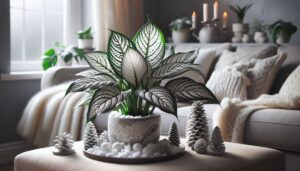
Dieffenbachia ‘Tropic Snow’ ‘Tropic Snow’
- Foliage: Broad, creamy-white leaves adorned with dark green speckles and splotches.
- Size: Compact growth habit, ideal for tabletop or shelf display.
- Light Requirements: Thrives in bright, indirect light but can tolerate lower light conditions.
- Care: Keep soil consistently moist but avoid overwatering to prevent root rot.
-
Dieffenbachia ‘Camille’
- Foliage: Striking foliage featuring creamy-white centers and dark green margins.
- Size: Moderate growth habit, suitable for both indoor and outdoor settings.
- Light Requirements: Prefers bright, indirect light but can adapt to moderate light conditions.
- Care: Maintain evenly moist soil and provide occasional misting to increase humidity.
-
Dieffenbachia ‘Rudolph Roehrs’
- Foliage: Vibrant leaves with a mosaic-like pattern of green, yellow, and white.
- Size: Large, bushy growth habit, making it a standout focal point in any room.
- Light Requirements: Flourishes in bright, indirect light but can tolerate moderate light levels.
- Care: Water thoroughly when the top inch of soil feels dry, and avoid prolonged exposure to direct sunlight.
-
Dieffenbachia ‘Compacta’
- Foliage: Compact, lance-shaped leaves featuring creamy-white veins against dark green backgrounds.
- Size: Petite growth habit, perfect for small spaces or as part of a mixed plant arrangement.
- Light Requirements: Adaptable to various light conditions, including low to moderate indirect light.
- Care: Allow the soil to dry slightly between waterings, and provide occasional pruning to maintain shape.
-
Dieffenbachia
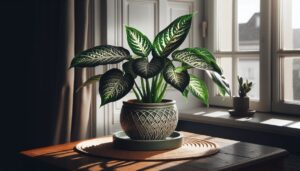
Dieffenbachia amoena in decorative pot ‘Sterling’
- Foliage: Striking silver-gray leaves with dark green veins, creating an elegant contrast.
- Size: Medium to large growth habit, making it suitable for both indoor and outdoor environments.
- Light Requirements: Flourishes in bright, indirect light but can tolerate lower light levels.
- Care: Water thoroughly but allow the soil to dry out slightly between waterings to prevent waterlogging.
Caring for Dieffenbachia: Essential Tips for Success
While Dieffenbachia varieties may differ in appearance, their care requirements share many similarities. By providing proper care and attention, you can ensure that your Dieffenbachia thrives and continues to grace your home with its lush foliage. Here are some essential tips for caring for Dieffenbachia:
- Light Requirements:
- Dieffenbachia prefers bright, indirect light. Place your plant near a window where it can receive filtered sunlight throughout the day.
- Avoid exposing Dieffenbachia to direct sunlight, as this can scorch its leaves. However, it can tolerate lower light conditions, making it suitable for areas with limited natural light.
- Watering:
- Keep the soil consistently moist during the growing season, typically spring through fall. Water thoroughly when the top inch of soil feels dry to the touch.
- Be cautious not to overwater, as this can lead to root rot. Ensure proper drainage by using a well-draining potting mix and allowing excess water to escape from the drainage holes in the bottom of the pot.
- Humidity:
- Dieffenbachia thrives in moderately humid environments. Increase humidity levels by misting the leaves regularly or placing a humidity tray filled with water and pebbles beneath the plant.
- Avoid placing Dieffenbachia near drafts or heating vents, as dry air can cause the leaf edges to brown.
- Temperature:
- Maintain a consistent room temperature between 65-80°F (18-27°C) for optimal growth. Avoid exposure to cold drafts or sudden temperature fluctuations, as this can stress the plant.
- Dieffenbachia is sensitive to cold temperatures and should be protected from temperatures below 50°F (10°C), which can cause leaf damage.
- Fertilizing:
- Feed your Dieffenbachia with a balanced liquid fertilizer diluted to half-strength every 4-6 weeks during the growing season. Reduce feeding frequency during the winter months when growth slows.
- Avoid over-fertilizing, as this can result in salt buildup in the soil and cause damage to the plant’s roots.
Common Issues and Troubleshooting Guide for Dieffenbachia
While Dieffenbachia is generally a resilient and easy-to-care-for plant, it can encounter certain issues that may affect its health and appearance. Being aware of common problems and knowing how to address them promptly can help you maintain a thriving Dieffenbachia in your home. Below, we’ve compiled a troubleshooting guide to help you identify and resolve potential issues:
- Yellowing Leaves:
- Cause: Overwatering or underwatering, excessive sunlight, or nutrient deficiencies.
- Solution: Adjust watering frequency to ensure the soil is evenly moist but not waterlogged. Move the plant to a location with less direct sunlight. Feed the plant with a balanced fertilizer to address nutrient deficiencies.
- Brown Leaf Tips:
- Cause: Low humidity, underwatering, or exposure to cold drafts.
- Solution: Increase humidity around the plant by misting its leaves regularly or placing a humidity tray nearby. Ensure the plant receives adequate water, and avoid placing it near drafts or heating vents.
- Wilting or Drooping Leaves:
- Cause: Underwatering, root rot due to overwatering, or inadequate drainage.
- Solution: Check the moisture level of the soil and adjust watering accordingly. If the soil is waterlogged, repot the plant in well-draining soil and trim any rotted roots. Ensure proper drainage by using a pot with drainage holes.
- Pests:
- Common pests affecting Dieffenbachia include spider mites, mealybugs, and scale insects.
- Solution: Inspect the plant regularly for signs of pests, such as webbing, sticky residue, or visible insects. Treat infestations with insecticidal soap or neem oil, ensuring thorough coverage of the foliage and stems.
- Leaf Drop:
- Cause: Stress from environmental changes, such as temperature fluctuations or drafts, or inadequate light conditions.
- Solution: Maintain stable environmental conditions and avoid sudden changes in temperature or light exposure. Provide adequate light for the plant’s needs and avoid placing it in areas with low light levels.
Propagation Methods for Dieffenbachia: A Guide for Plant Enthusiasts
For avid plant enthusiasts looking to expand their collection or share the beauty of Dieffenbachia with friends and family, propagation offers an exciting opportunity to grow new plants from existing ones. While Dieffenbachia can be propagated through various methods, including stem cuttings and division, each approach requires careful attention to ensure success. Below, we explore the most common propagation methods for Dieffenbachia:
- Stem Cuttings:
- Select a healthy stem with several leaves and make a clean cut just below a leaf node using a sharp, sterilized knife or pair of scissors.
- Remove any lower leaves to expose a node where roots will form.
- Dip the cut end of the stem in rooting hormone to encourage root development.
- Plant the cutting in a well-draining potting mix and keep the soil consistently moist.
- Place the cutting in a warm, humid environment with bright, indirect light and monitor its progress regularly.
- Division:
- Carefully remove the plant from its pot and gently separate the root ball into smaller sections, ensuring that each division has several stems and a healthy root system.
- Plant each division in its own pot filled with fresh potting mix, ensuring that the soil is evenly moist but not waterlogged.
- Place the newly divided plants in a warm, humid environment with bright, indirect light and provide regular care as they establish themselves.
- Air Layering:
- Select a healthy stem and make a small incision in the bark just below a leaf node.
- Insert a toothpick or small stick into the incision to keep it open, then wrap the area with moist sphagnum moss.
- Cover the moss with plastic wrap and secure it in place with tape or a rubber band.
- Monitor the moss regularly and keep it moist, ensuring that roots begin to form within a few weeks.
- Once roots have developed, carefully cut the stem below the rooted section and plant it in a pot filled with fresh potting mix.
- Water Propagation:
- Cut a healthy stem with several leaves and place it in a container of water, ensuring that at least one leaf node is submerged.
- Change the water regularly to prevent stagnation and algae growth.
- Once roots have developed, transfer the cutting to a pot filled with fresh potting mix and continue to care for it as usual.
Decorating with Dieffenbachia: Enhancing Your Living Space
Dieffenbachia’s lush foliage and striking patterns make it not only a popular choice for plant enthusiasts but also a versatile decor element that can elevate any living space. Whether you’re aiming to create a vibrant indoor jungle or add a touch of greenery to a minimalist setting, Dieffenbachia offers endless possibilities for enhancing your home’s aesthetic appeal. Here are some creative ways to incorporate Dieffenbachia into your decor:
- Statement Plant:
- Place a large Dieffenbachia in a decorative pot as a focal point in your living room, entryway, or dining area. Its bold foliage and vibrant presence will instantly draw attention and infuse your space with natural beauty.
- Vertical Garden:
- Create a vertical garden by hanging multiple smaller Dieffenbachia plants in macramé plant hangers or wall-mounted planters. This cascading arrangement adds visual interest and fills empty wall space with lush greenery.
- Mixed Planters:
- Pair Dieffenbachia with other indoor plants, such as ferns, pothos, or snake plants, in mixed planters or terrariums. The contrasting textures and colors of different foliage varieties create dynamic arrangements that enhance any room.
- Tabletop Display:
- Place a compact Dieffenbachia variety on a coffee table, side table, or bookshelf to add a touch of greenery to smaller spaces. Choose decorative pots or planters that complement your decor style for a cohesive look.
- Office Greenery:
- Bring the beauty of nature into your workspace by adding a Dieffenbachia plant to your office desk or cubicle. Its air-purifying properties can help improve indoor air quality while creating a more inviting and productive environment.
- Seasonal Decor:
- Incorporate Dieffenbachia into your seasonal decor by accessorizing it with festive accents such as ornaments, ribbons, or fairy lights during the holidays. This versatile plant seamlessly transitions between different decor themes throughout the year.
- Outdoor Oasis:
- Extend your living space outdoors by using Dieffenbachia to decorate your patio, balcony, or garden. Choose hardy varieties that can tolerate outdoor conditions and place them in decorative containers or planters to create a green oasis in any outdoor setting.
Conclusion: Embracing the Beauty of Dieffenbachia
In the lush world of indoor plants, Dieffenbachia stands out as a true gem, captivating hearts with its vibrant foliage and unrivaled charm. Throughout this exploration of Dieffenbachia varieties, care tips, propagation methods, and decorative ideas, one thing remains abundantly clear: the beauty and versatility of this beloved plant know no bounds.
From the elegant ‘Camille’ to the striking ‘Rudolph Roehrs,’ Dieffenbachia varieties offer an exquisite array of colors, patterns, and sizes to suit every taste and preference. With proper care and attention, these botanical wonders flourish, enriching our living spaces with their lush greenery and purifying the air we breathe.
Propagation opens up new avenues for plant enthusiasts to expand their collections and share the joy of growing with others. Whether through stem cuttings, division, air layering, or water propagation, the journey of nurturing new life from existing plants is a rewarding experience that deepens our connection to nature.
As we adorn our homes and workspaces with Dieffenbachia, we not only enhance our surroundings aesthetically but also cultivate a sense of well-being and tranquility. The simple act of caring for these plants reminds us to slow down, observe, and appreciate the beauty that surrounds us in the natural world.
In conclusion, let us continue to embrace the beauty of Dieffenbachia, nurturing these botanical treasures with love and admiration. May they continue to thrive as symbols of growth, resilience, and the enduring power of nature’s grace.
Thanks for allowing us to share with you. Visit us at The Landscape Connection if you happen to be in the area.


